
Curator’s statement
Unlock the beauty of Italy through the lens of mathematics on this 10-day journey designed for the endlessly curious. From the geometric genius of Brunelleschi’s dome to the hidden gem of MathEureka, a whimsical museum in the Apennines where puzzles and illusions bring math to life, you’ll explore how numbers shaped Renaissance art, architecture and innovation. Walk in the footsteps of da Vinci and Galileo, discover elegant symmetry in piazzas and palaces and savor rich Italian culture along the way. This is not just a trip — it’s a celebration of intellect, wonder and the enduring elegance of numbers.
The Fora Difference
Book with Jane to access exclusive perks and experiences on your trip.
Killer perks
Free upgrades, spa credits and more—we got you
Personalized recs
Customized travel planning for your style
Insider knowledge
Expert advice from people who’ve actually been there
Where to stay
Unlock perks by contacting Jane to book your trip.
Day 1: Arrival in Florence – the geometry of genius
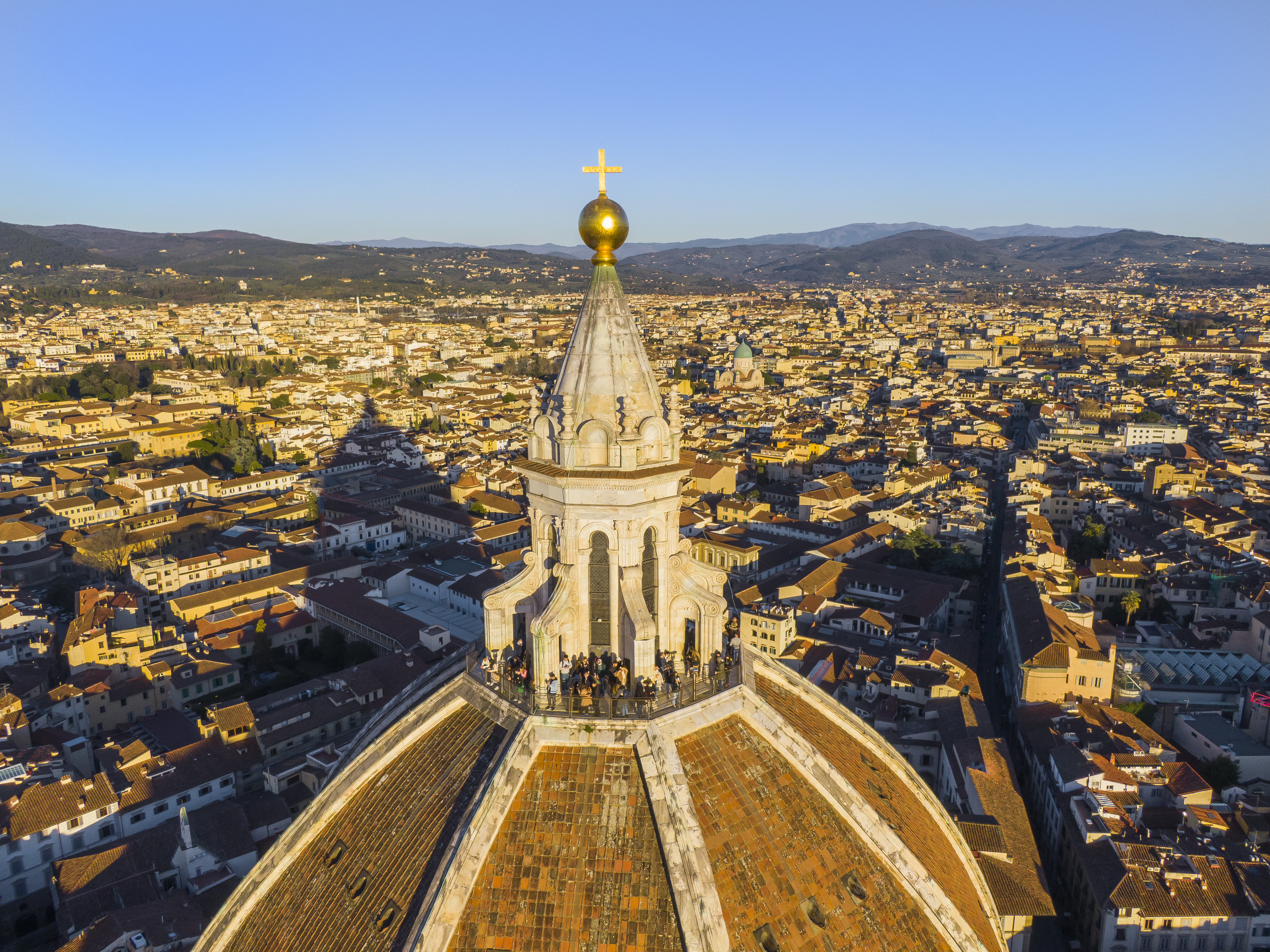
A marvel of Renaissance engineering: Brunelleschi’s Dome in Florence, where geometry, vision and architectural genius converged to reshape the skyline — and the future of design.
Arrive in Florence, Italy’s Renaissance capital and a city built on proportion, symmetry and beauty. After checking into your hotel in the historic center, take a relaxed, self-guided walk to get your bearings and soak in the architectural harmony that defines the city. Begin at Piazza della Repubblica, noting its clean lines and perfect square, then continue to Piazza della Signoria, where classical sculpture and civic space reflect the mathematical ideals of balance and order.
Make your way to the Florence Cathedral (Duomo) and take in Brunelleschi’s Dome from the outside — tomorrow, you’ll climb it. Pause at sunset on the Ponte Vecchio, observing the layered geometry of the bridge’s arches and shops.
Evening: Enjoy a relaxed dinner at a local trattoria. Try dishes with roots in Fibonacci’s Tuscany, like ribollita or bistecca alla fiorentina, and toast to the beginning of your mathematical adventure.
Day 2: Florence – proportion, perspective & Brunelleschi’s masterpiece
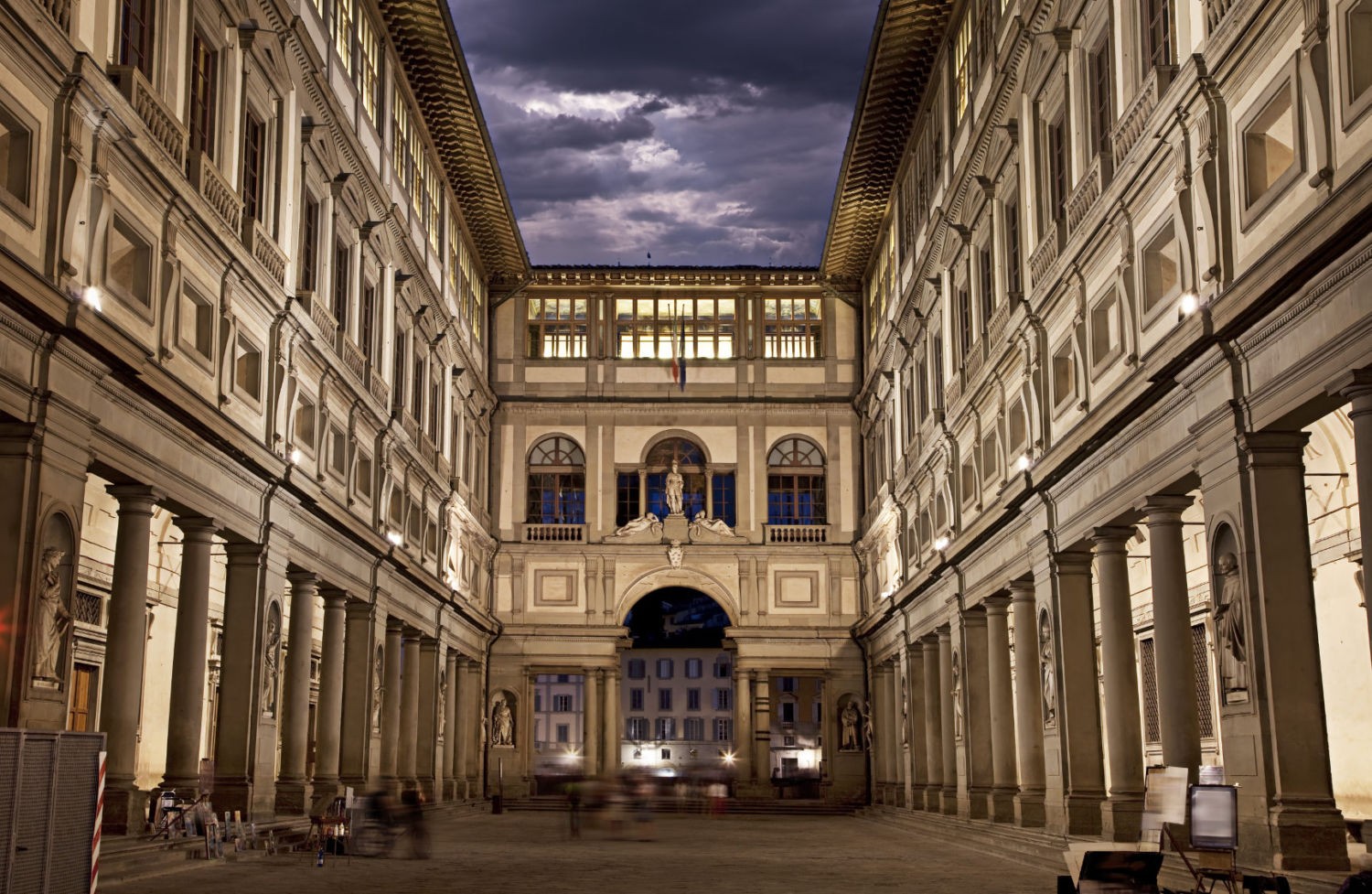
A perfect study in linear perspective — Florence’s Uffizi Gallery, where Renaissance art meets mathematical order under a twilight sky.
Begin your day with a self-guided visit to the Florence Cathedral (Santa Maria del Fiore) and Brunelleschi’s Dome. Climb the 463 steps to the top, passing between the inner and outer shells — a physical experience of the dome’s ingenious double structure. Notice the use of octagonal symmetry, herringbone brickwork and the revolutionary math that made it all possible.
Afterward, explore the Opera del Duomo Museum, where original tools and scale models reveal the geometric problem-solving behind Florence’s most iconic silhouette.
In the afternoon, continue your journey into mathematical beauty at the Uffizi Gallery (pre-book tickets). As you move through rooms filled with works by da Vinci, Botticelli and Piero della Francesca, look for hidden mathematics: the golden ratio, linear perspective and harmonic composition at play in Renaissance masterpieces.
Before dinner, take time to browse at Libreria Ghibellina, an independent bookstore tucked into a quiet corner of the historic center. Its thoughtful curation includes books on Renaissance philosophy, geometry in art and Italian scientific thought — a perfect place to find a meaningful souvenir for the mind.
Evening: Enjoy a quiet dinner or aperitivo in a local piazza. Florence will continue revealing its layers, the more mathematically you look at it.
Day 3: Pisa – tilted logic & mathematical instruments
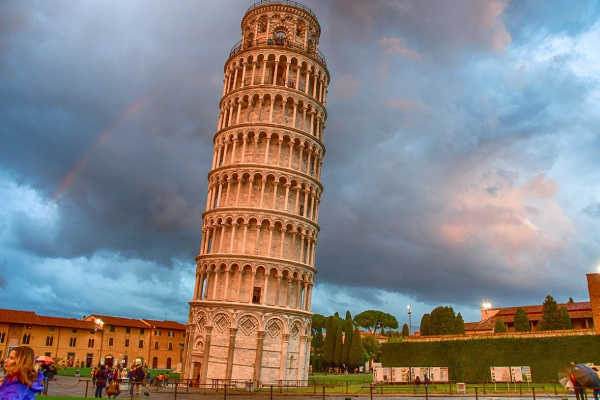
An elegant mistake that became an icon — the Leaning Tower of Pisa reminds us that even flawed foundations can inspire centuries of mathematical curiosity.
This morning, take a leisurely train from Florence to Pisa (about an hour). Drop your bags at your hotel or luggage storage near the station, then walk or taxi to the Piazza dei Miracoli — an open-air stage where math and architecture meet gravity head-on.
Begin with a climb up the Leaning Tower of Pisa, a miscalculated masterpiece whose unintended tilt made it a case study in center of mass, load distribution and engineering correction. Ascend its 294 steps slowly and feel the subtle slant as you go — an experience that brings theoretical physics to life.
Next, step into the Camposanto Monumentale, where Renaissance frescoes were once drawn using exacting geometric perspective. Then walk to the Museo degli Strumenti per il Calcolo (Museum of Mathematical Instruments), located within the University of Pisa campus. Inside, you’ll find centuries-old calculating machines, astrolabes, compasses and some of the earliest tools used to measure the cosmos and solve abstract problems. It’s a quiet, cerebral stop that rewards close attention.
As you head back into town, look up: Galileo is said to have studied pendulums by watching a swinging lamp in the Pisa Cathedral nearby. Whether legend or fact, the story anchors the city’s deep connection to science.
Evening: Dine at a trattoria tucked along the Arno River and reflect on how a flawed foundation birthed a global icon — and a deeper appreciation for mathematical resilience.
Day 4: Pennabilli – puzzles, poetry & the playful side of math
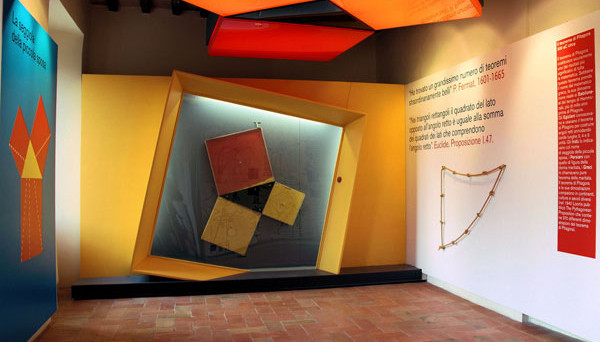
At MathEureka in Pennabilli, Euclid’s theorems leap off the page — inviting you to see, touch and play with the beauty of mathematical form.
Today you leave the tourist trails behind and enter a world where mathematics becomes touchable, poetic and quietly profound. Travel from Pisa to the hilltop town of Pennabilli, nestled in the Apennines. (Recommended: train to Rimini, then car transfer or rental car for the final stretch.)
This is a day of slow discovery and unexpected delight. After arriving and settling into a local inn or agriturismo, make your way to MathEureka, a one-of-a-kind museum where math is explored through puzzles, illusions, mirrors, levers and light. Designed by poet and screenwriter Tonino Guerra, this small but brilliant space invites visitors to experience math as creative, intuitive and even emotional.
You’ll wander through rooms filled with geometric toys, perspective-bending exhibits and interactive installations that make abstract concepts feel personal. There’s no rush — this is math at its most human.
In the afternoon, take a gentle walk through town. Pennabilli is known for its artistic soul, panoramic views and quiet philosophical spirit. Explore the Places of the Soul art path, or simply relax with a book and a glass of wine as the sun dips behind the hills.
Evening: Dine at Ristorante Il Piastrino, a refined yet welcoming family-run restaurant known for its seasonal tasting menus and elegant, harmonious dishes. With deep roots in local tradition and a thoughtful balance of flavors and form, it’s the perfect closing to a day devoted to the elegant side of mathematics.
Day 5: To Bologna – foundations of knowledge and the first mathematicians
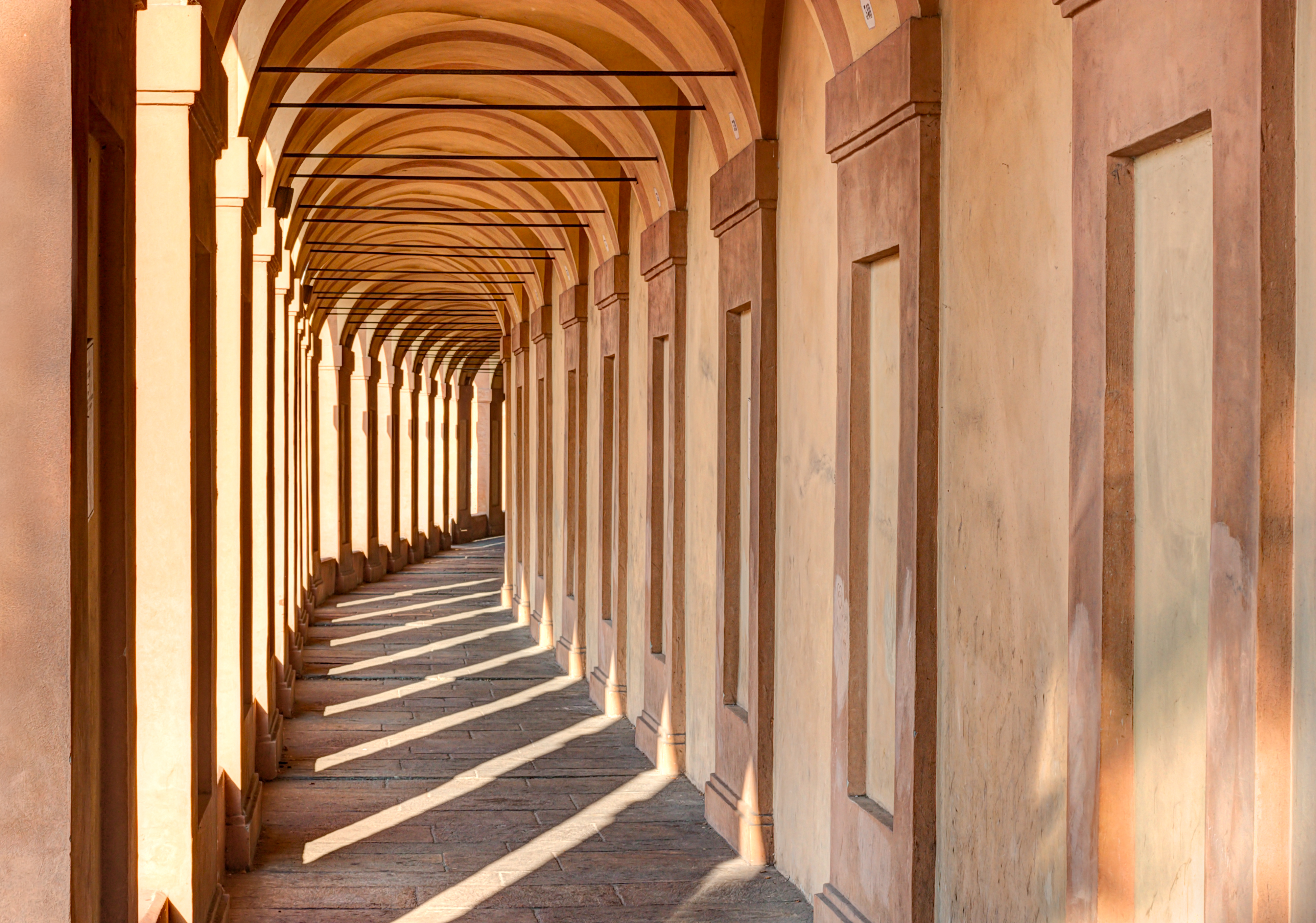
Precision in repetition — Bologna’s iconic porticoes offer a rhythmic dance of light, shadow and architectural symmetry.
Today, continue your journey north to Bologna, one of Europe’s oldest university cities and a vital hub in the history of science and mathematics. Take the scenic route out of Pennabilli, enjoying views of the Apennines before arriving in Bologna by early afternoon. (Recommended: drive or transfer to Rimini, then train to Bologna.)
After checking into your hotel near the historic center, set out on a self-guided walking tour. Begin in Piazza Maggiore, then visit the Archiginnasio, the former seat of the University of Bologna. Step inside the Teatro Anatomico, where scholars once used geometry and dissection to understand the human body — an enduring symbol of knowledge built on measurement and inquiry.
If time allows, walk to the Basilica of San Petronio to see the Cassini Meridian Line, a mathematically precise solar calendar inlaid into the basilica floor. It’s a quietly stunning fusion of faith and science, and a reminder of the elegance of applied mathematics.
Evening: Dine at Salumeria Simoni, a beloved spot tucked into the Quadrilatero district. With its rustic tables and shelves lined with Parmigiano, prosciutto and balsamic vinegar, this is where you taste the logic of tradition. Order a tagliere (charcuterie board) and a glass of Lambrusco, and savor a meal where flavor is built on balance, proportion and time.
Day 6: Bologna – geometry, astronomy & the rhythm of the city

A Renaissance model of the cosmos — where art, astronomy and mathematics align to chart the heavens with elegant precision.
Start your morning with a visit to the Museo di Palazzo Poggi, home to Bologna’s vast scientific collections. This often-overlooked treasure houses Renaissance-era globes, astrolabes, measuring instruments and anatomical models — all part of the university’s quest to quantify and understand the natural world. Don’t miss the beautifully illustrated mathematics and astronomy rooms, filled with historical tools of calculation and celestial observation.
From there, head to the Museo della Specola, Bologna’s historic observatory, located in one of the university’s towers. Climb to the top for a panoramic view of the city and a closer look at the tools once used to study the heavens with mathematical precision.
In the afternoon, explore the city’s mathematical soul through its very structure. Walk a portion of Bologna’s UNESCO-listed porticoes — perfect examples of modular architecture and civic geometry. Look for repeating columns, arches and proportional relationships in their design. A good route takes you from Via Zamboni through the Quadrilatero, ending at Piazza Santo Stefano, a square filled with visual symmetry.
For a tactile, flavorful encounter with ratios and harmony, step into Tamburini, a historic deli and wine bar, for lunch or an afternoon snack. The curated balance of salt, fat and acidity in their regional specialties is a master class in culinary proportion.
Evening: Enjoy a relaxed dinner or aperitivo nearby, or catch a local music performance if one is available — after all, mathematics and music share the same language of structure and rhythm.
Day 7: Bologna – symmetry, synthesis & a farewell to form
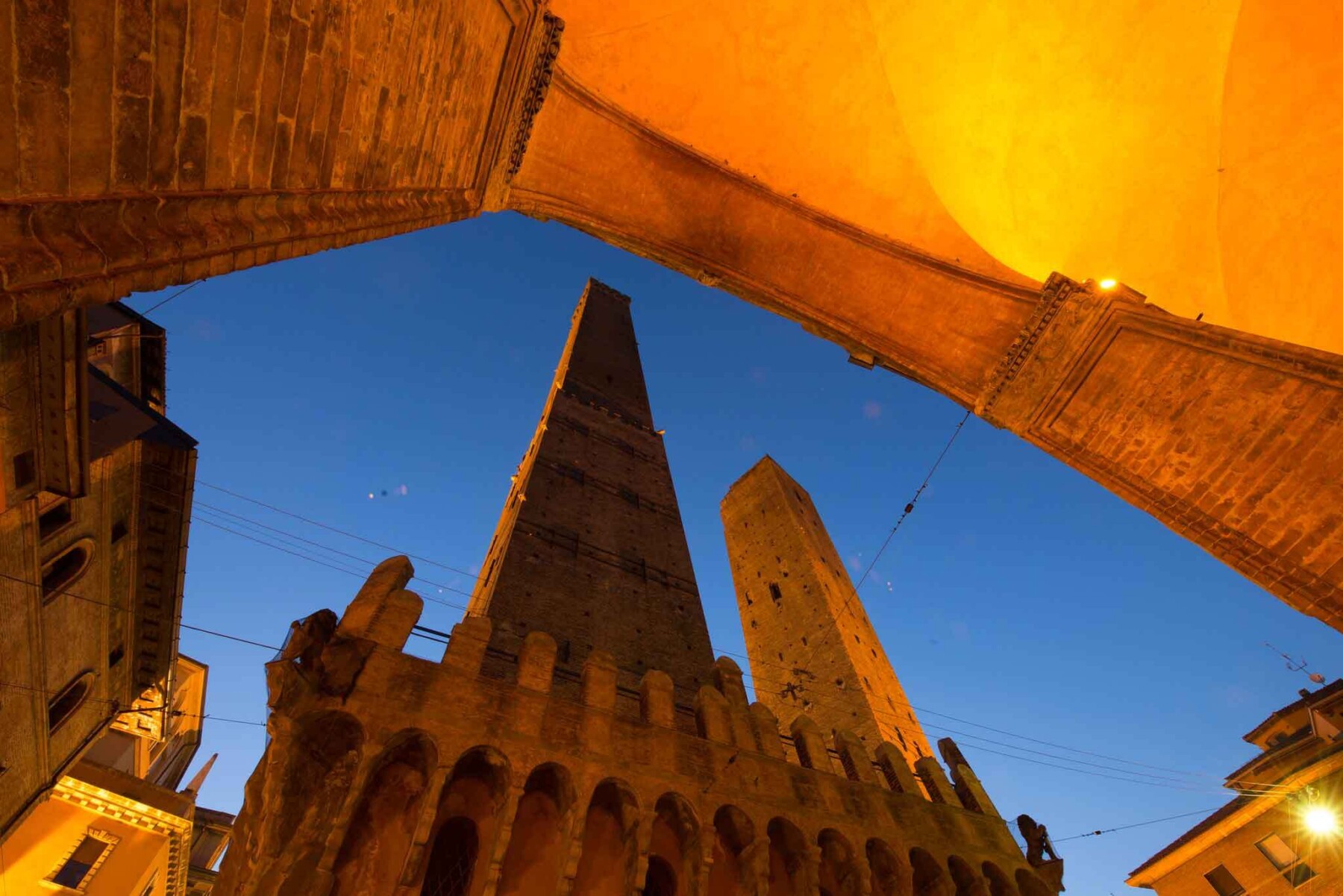
Rising at skewed angles, Bologna’s Two Towers frame the sky like a problem and its proof — leaning monuments to perspective, proportion and possibility.
On your final full day in Bologna, let your curiosity guide you. Start with a slow morning coffee at Caffè Zamboni or Caffè Terzi, two local favorites where the morning rituals of Italian life unfold with quiet rhythm and structure.
Then, choose your own math-inspired adventure:
Option 1: Climb the Torre degli Asinelli, Bologna’s towering medieval symbol. With its 498 uneven steps, it's a physical encounter with geometry, gravity and perspective. At the top, take in the red-tiled symmetry of the city stretching to the Apennines.
Option 2: Visit the International Museum and Library of Music, where scores, instruments and manuscripts reveal the harmonic connection between mathematics and music. Pythagorean ratios, tuning systems and compositional structures all echo the logic of numbers.
Option 3: Enjoy a quiet wander through Giardini Margherita, a landscaped garden where nature and geometry meet. Bring along a book or journal to sketch reflections from the journey — patterns you've seen, questions sparked or insights gained.
For lunch or an early dinner, revisit Tamburini or try Osteria dell’Orsa, a beloved, informal spot popular with university students and scholars alike. Their handmade tagliatelle al ragù is a study in texture and proportion.
Evening: Toast your week of exploration with a final glass of Lambrusco or Pignoletto. This journey has been about seeing the world — its structures, shapes and systems — through a mathematical lens. And like all beautiful theorems, it ends not with a full stop, but with possibility.
Day 8: Return to Florence – the mind of Leonardo
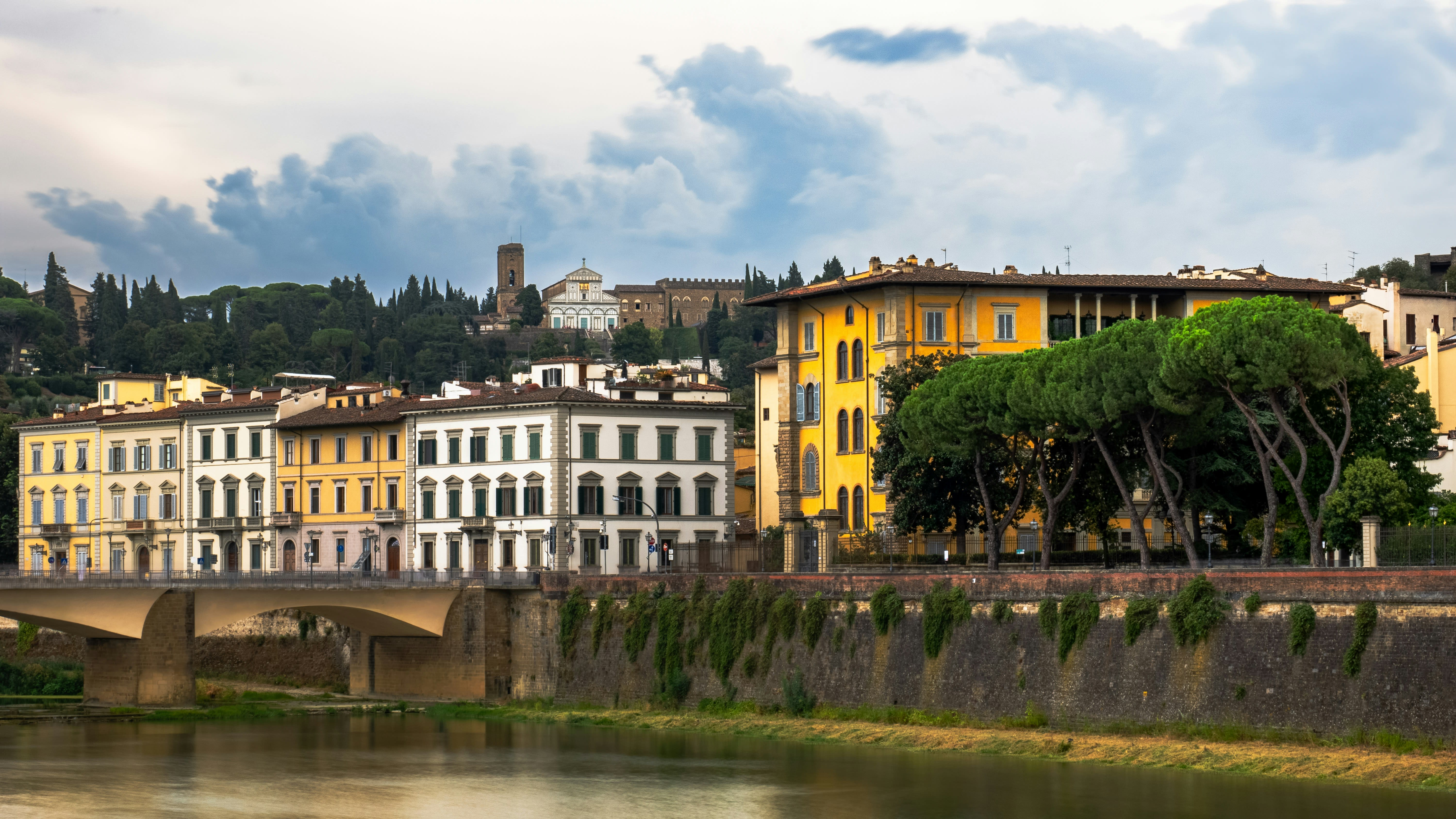
Travel back to Florence this morning by high-speed train from Bologna (approximately 40 minutes). This return is more than a loop — it’s a deepening. You’ve explored how math shapes structures, stars and systems. Now, you revisit Florence to enter the mind of the Renaissance's most curious thinker: Leonardo da Vinci.
Spend the afternoon at the Museo Leonardo da Vinci, where detailed models built from Leonardo’s codices bring his mathematical imagination to life. See how his observations of flight, motion, proportion and mechanics were grounded in deep mathematical intuition. These are not just inventions — they are elegant equations in motion.
If time allows, visit the nearby Museo Galileo, home to one of the world’s greatest collections of scientific instruments. Admire the precision and beauty of astrolabes, armillary spheres and geometric compasses — tools that turned abstract theory into Renaissance discovery.
Evening: Cross the Arno to the artisan-rich Oltrarno district and dine at Trattoria Cammillo, a Florentine institution beloved by locals. The menu blends timeless Tuscan cooking with subtle elegance — order the artichoke flan or hand-cut pasta, and enjoy a glass of Chianti in an atmosphere that balances tradition and creativity with quiet precision. It’s the perfect spot to toast a day immersed in the mind of a genius.
Day 9: Florence – artisanship, geometry & the human hand
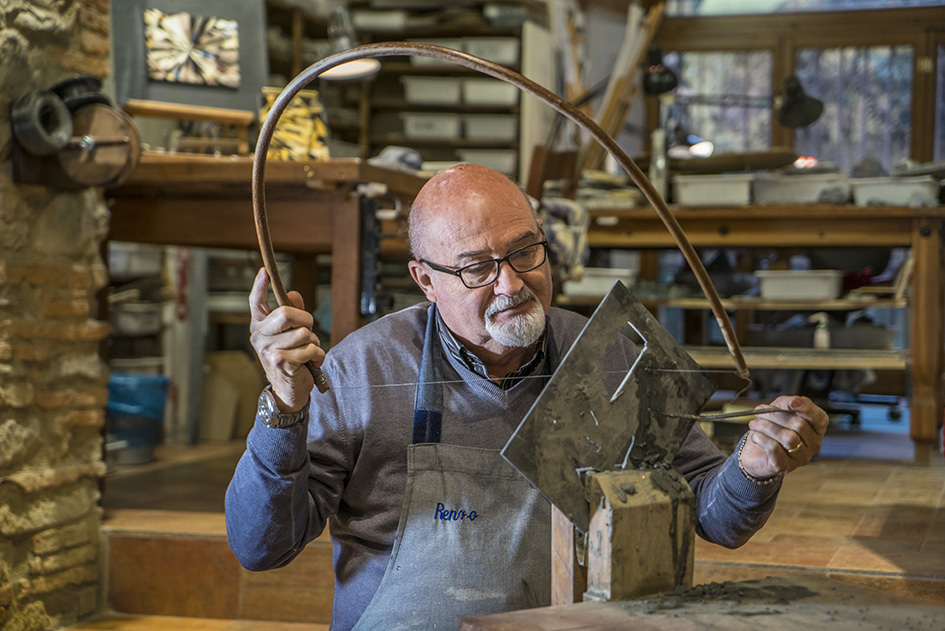
At Scarpelli Mosaici in Florence, centuries of mathematical precision are held in the hands of a master — where stone becomes symmetry, and geometry becomes art.
Your final full day in Florence invites you to step into the quiet world of craft — where centuries-old traditions bring mathematical principles to life through human hands.
Begin your morning or afternoon with a visit to Scarpelli Mosaici, a renowned family-run workshop specializing in Florentine commesso — intricate stone mosaics crafted from semi-precious stones. These stunning works are built on precision, symmetry and geometric design, echoing the same mathematical foundations you've traced throughout your journey. You’ll have the chance to observe artisans at work and gain insight into how they cut and fit stone with millimeter-level accuracy to form elaborate patterns and images. Tip: While Scarpelli Mosaici is open to visitors, it's best to email ahead to confirm that artisans will be present and working during your visit.
Afterward, stroll through the nearby streets and reflect on how geometry continues to shape beauty — from mosaic art to the proportions of the buildings around you. If you’re still curious, pop into a design-forward paper shop or gallery in the Oltrarno to see how sacred geometry appears in bookbinding, marbling and contemporary art.
Evening: For your final dinner, settle in at Osteria del Cinghiale Bianco, a warm, vaulted trattoria just across the river. Known for its rich Tuscan fare and welcoming charm, it’s the perfect setting for a farewell toast— one that celebrates not just travel, but transformation.
Day 10: Departure – the beauty of completion
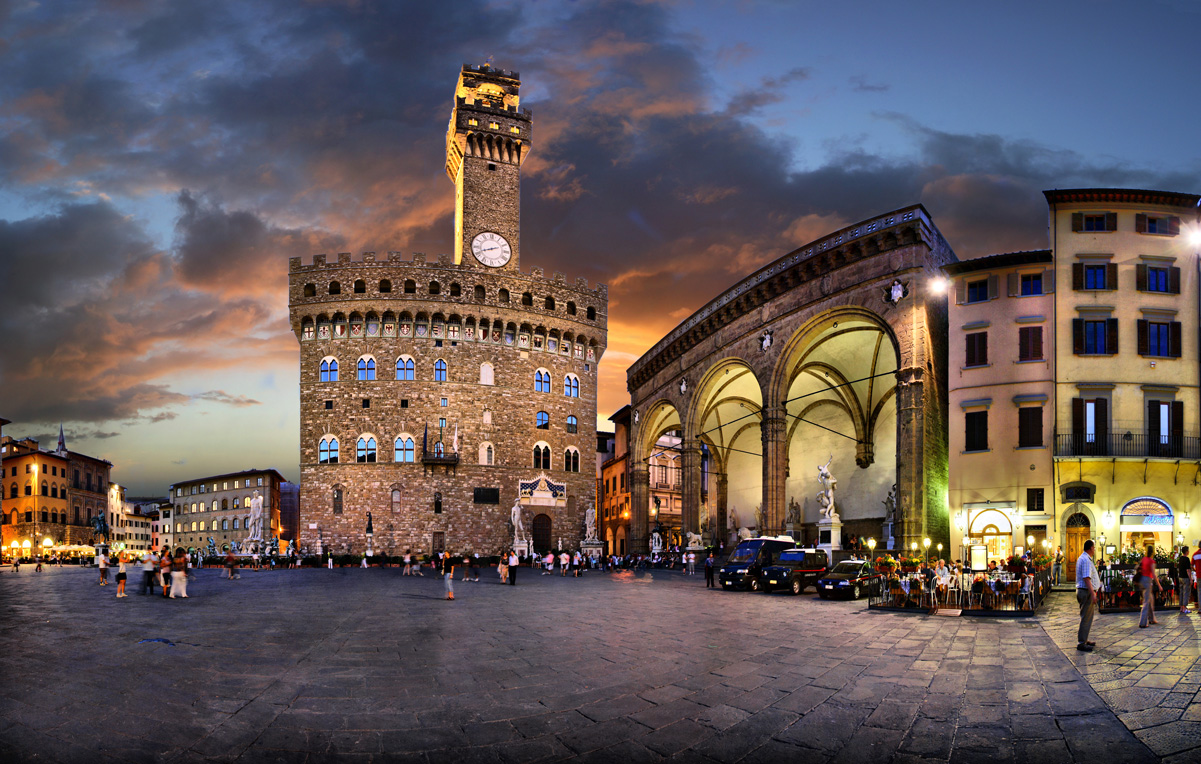
Evening in Piazza della Signoria — where centuries of art, power and proportion converge beneath a sky that still invites questions.
As your journey through Italy’s mathematical soul comes to a close, take the morning slowly. If time allows before your flight or onward travels, revisit a favorite spot — perhaps the Piazza della Repubblica, where symmetry and city life intersect, or the Duomo, now familiar, yet still awe-inspiring. Florence doesn’t ask to be rushed. It rewards the quiet observer.
Stop for a final cappuccino or a handwritten reflection in your journal. You’ve followed the paths of da Vinci and Brunelleschi, seen numbers in domes and mosaics, walked meridian lines and touched the tools that helped measure the cosmos.
Now, like all elegant theorems, your journey closes with clarity and wonder — not because all the answers are known, but because you’ve seen how beautifully the questions are framed.
Arrivederci. May you travel onward with eyes sharpened by geometry, and a spirit lit by infinite curiosity.
Need to know
Before you go
Advance reservations: Many key sites, including the Uffizi Gallery, Brunelleschi’s Dome, Museo Galileo and Museo Leonardo da Vinci, require timed-entry tickets. Booking ahead ensures access and flexibility.
Artisan visits: For visits to Scarpelli Mosaici or similar workshops, it’s important to email ahead to confirm availability and ensure artisans are present during your visit.
Footwear and clothing: Expect to walk on cobblestones, climb towers and spend time in both churches and workshops. Comfortable walking shoes and modest attire for religious sites are recommended.
Transportation
Train travel: Trains are the most efficient way to travel between Florence, Pisa and Bologna. High-speed and regional trains run frequently. Download the Trenitalia or Italo app for easy booking.
Reaching Pennabilli: This is the only leg that requires a car or private transfer. Take a train to Rimini, then arrange a car rental or driver for the last stretch.
Tickets and validation: For regional train tickets, always validate them in the station before boarding. High-speed train tickets do not need validation.
Museum & site tips
Travel light: Large bags may not be allowed inside museums. Many sites offer lockers or cloakrooms.
Photography restrictions: Some museums limit or prohibit photography. Look for signage or ask staff.
Opening hours: Double-check holiday and weekend hours, especially for smaller museums and artisan workshops.
Cultural & intellectual engagement
Bring a notebook: This itinerary encourages observation and reflection. A small sketchbook or journal enhances the experience.
Suggested reading:
Leonardo da Vinci by Walter Isaacson
The Golden Ratio by Mario Livio
How to Read a Church by Richard Taylor (for interpreting architectural symbolism)
Pace yourself: The richness of this trip lies in noticing details. Allow time each day to pause, observe and reflect.
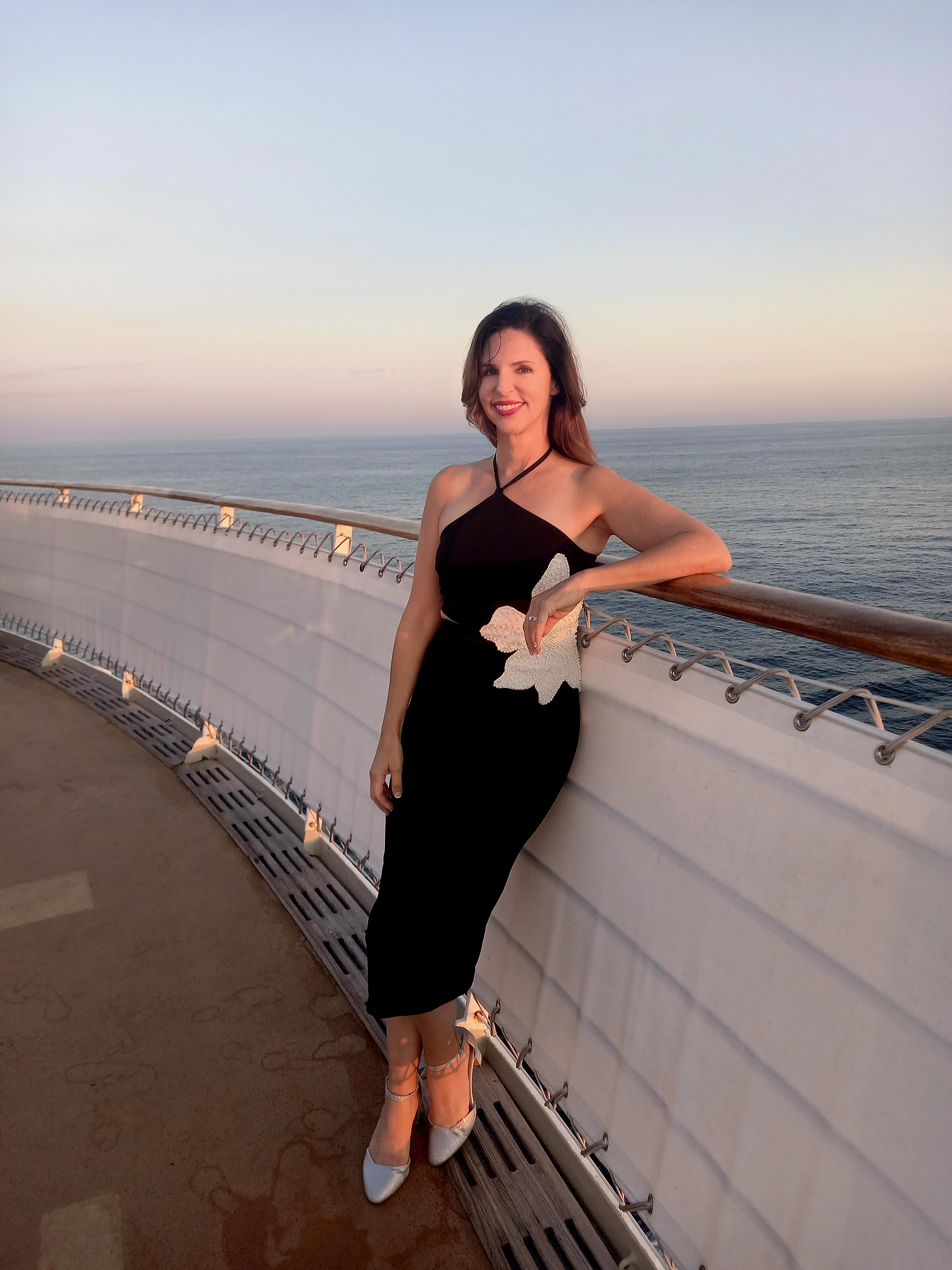
Travel Advisor
Jane Hermstedt

Get in touch with Jane
Did you like this guide? Reach out to customize and book your own experience. Or, just to chat about travel in general.
You can expect a response from Jane within 1–2 business days. You’ll also be subscribed to our traveler newsletter (you can unsubscribe at any time).
For more inspiration and insider recommendations, visit our Italy page.